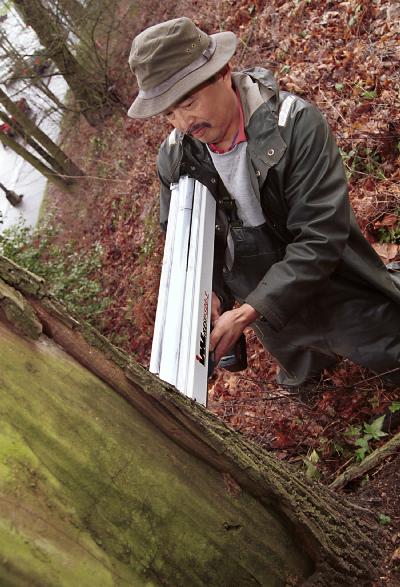March 6, 2003
Gardeners keep a close eye on campus trees
Citizens of the UW love their trees. In fact, they love them so much that they can get quite exercised when they see someone chopping off limbs, or, heaven forbid, taking down a whole tree.
For those people the UW gardeners have a message: “We’re on your side!” Getting rid of tree branches or whole trees, they say, is done only when it’s absolutely necessary.
Gardeners are, in fact, always looking out for the trees. It’s their job to monitor the trees’ health, identify trees in trouble and decide when a tree needs surgery or an assisted death. And when it comes time to cut back or take out a tree, it’s usually the gardeners who have to do the job. Only if the tree is inaccessible to a boom lift truck and thus has to be climbed is the work contracted out.
“There’s an arborist who comes out about once a month,” says gardener lead Gordon Yumibe. “We try to identify trees with problems and have him look at them and help us decide what to do.”
There was a time when the campus had its own arborist, but because of budget cuts he wasn’t replaced when he left, so now the gardeners are on their own, with a little consultation.
To help them in their task, they have a new piece of equipment called a resistograph. Essentially, it’s a machine that measures the resistance of a drill probe going in to the tree and prints out a graph that shows how much of the wood is sound and where it’s decayed.
But evaluating trees isn’t an exact science. “Just because a tree is decayed doesn’t mean it has to be taken out,” says Grounds Supervisor Bonnie Taylor. “It depends on how much decay there is and where that decay is located.”
Gardeners try to take a conservative approach, she says. When possible, they take only the portion of the tree that’s already dead. The resistograph helps them do that — permitting measurements where before they had to go on appearance. But the matter of safety always looms large.
“Sometimes I wake up in the middle of the night worrying about the trees,” Yumibe admits.
The worry, of course, is that a tree limb or a whole tree will come crashing down and injure or kill someone.
“We’re trying to take out what we have to and preserve the rest but it’s a tough call sometimes,” Yumibe says. “There are walkways around the trees, and people like to sit under them. We’re really cognizant of the fact that it’s a safety issue but there’s a large cry for preservation too and we have to balance it out.”
His biggest worry right now is the Big Leaf Maples on campus, some of which are very large and old enough that they have a variety of diseases and injuries. Gardeners are keeping an especially close eye on those.
But Taylor says that, in a way, all the campus trees are under scrutiny. “We’re short staffed right now,” she says, “but trees are a high priority. If you’ve got some ground cover, say, that needs work, you can put that off. Trees, on the other hand, we always have to pay attention to.”

